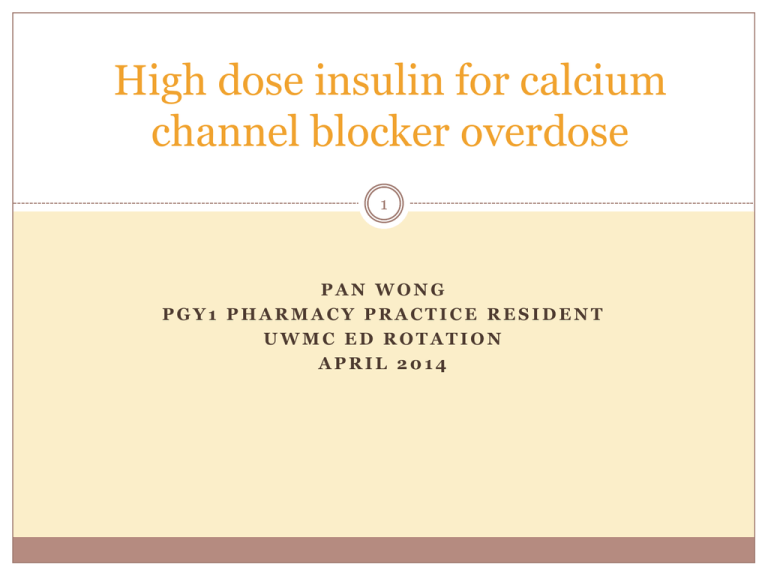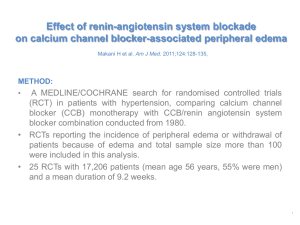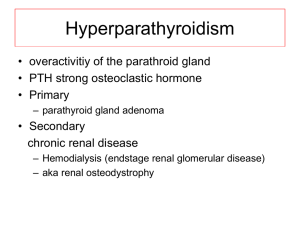
High dose insulin for calcium
channel blocker overdose
1
PAN WONG
PGY1 PHARMACY PRACTICE RESIDENT
UWMC ED ROTATION
APRIL 2014
Outline
2
Background
Basic Pharmacology Review
Clinical Presentation
Mechanism of Toxicity
Pharmacological management
High Dose Insulin at UWMC
Background
3
Calcium channel blockers (CCB) overdose is
associated with significant morbidity and mortality
American Association of Poison Control Centers
Exposure Surveillance System Annual Report 2012
Calcium channel blockers:
11,910 cases with 24 deaths
Highest mortality rate amongst cardiovascular
agents
Lyden AE, et al. Clin Toxicol . 2013 Dec;51(10):949-1229
Brief Pharmacology Review
4
Calcium signaling in cardiac myocytes
• Catecholamines (B-agonists)
activates Gs protein
• Activiates adenylate cyclace (AC)
converts ATP to cAMP
• cAMP activates protein kinase A
(PKA)
• Causes L-type calcium channel to
open leading to calcium influx
• Causes sarcoplasmic reticulum to
release Ca2+ contraction
Calcium Channel Blocker Mechanism of toxicity
5
The life-threatening toxicities are an extension of the
therapeutic effects on the cardiovascular system
Dihydropyridine
Acts predominately on peripheral vasculature
Non-dihydropyridine
Less selective- both cardiac & peripheral vasculature
In overdose, receptor selectivity is lost
Distinction between these agents may not be clinically evident
Shepherd G, et al. Ann Pharmacother. 2005 May;39(5):923-30.
Calcium Channel Blocker Mechanism of toxicity
6
Blockade of L-type calcium channels:
Myocardial cells
Smooth muscles
Weaken cardiac contraction & blunt cardiac automaticity
bradycardia & heart blocks
Relaxation of vascular smooth muscles hypotension
B-islet cells of pancreas
Inhibits insulin secretion
Reduces myocardial cells ability to use glucose reduced tissue
perfusion metabolic acidosis
Hyperglycemia
Clinical Presentation
7
Hypotension
Bradycardia
Cardiogenic shock
Heart block
Hyperglycemia
Metabolic acidosis
CNS: confusion, seizure, coma
Management
8
Supportive Care
Maintain airway
Treat hypotension with IV fluid boluses
Give atropine for initial treatment (0.5-1mg IV up to 3 doses)
Continuous cardiac monitoring
Consider GI decontamination
Gastric lavage
Within 1 -2 hours of ingestion
Whole bowel irrigation
For consumption of extended release formulations
Engebretsen KM, et al. Clin Toxicol. 2011 Apr;49(4):277-83.
Management: Pharmacologic Therapy
9
Calcium
MoA: augment
extracellular calcium to
overcome blocked
calcium channels to
maximize calcium entry
into cell
Management: Pharmacologic Therapy
10
Calcium
No optimal dosing has been established
Bolus
Calcium chloride: 10 to 20 mL of a 10% solution
Calcium gluconate: 30 to 60 mL of 10% solution
Continuous Infusion
Calcium chloride: 0.2 to 0.4 mL/kg per hour of 10% solution
Calcium gluconate: 0.6 to 1.2 mL/kg per hour of 10% solution
Precautions
Close monitoring of serum calcium
Use central line for calcium chloride
Safest agent is calcium gluconate
Efficacy:
Mixed clinical experience
Kerns, W. Emerg med Clin N Am 25 (2007): 209-331.
Management: Pharmacologic Therapy
11
Inotropes and vasopressors
MoA: Could increase inotropy, chronotropy, and
vasoconstriction (depending on selected agents)
Various agents cited in case reports:
Efficacy:
Epinephrine, Norepinephrine, Dopamine, Isoproterenol,
Dobutamine
No selected agent is universally effective
Best approach is to choose an agent based on hemodynamics
Kerns, W. Emerg med Clin N Am 25 (2007): 209-331.
Management: Pharmacologic Therapy
12
Inotropes and vasopressors
Dosing:
No set dosing guideline for this indication
Titrate to keep MAP >65
Levine et al. 2013
Many received doses much higher doses and did not appear to
experience complications
Associated with good clinical outcomes
Levine M, et al. Ann Emerg Med. 2013 Sep;62(3):252-8.
Management: Pharmacologic Therapy
13
Glucagon
MoA: exerts positive
inotropic and chronotropic
effects on the cardiac
myocytes by stimulating
adenylate cyclase through a
separate receptor
Management: Pharmacologic Therapy
14
Glucagon
Dosing
Start with 5mg IV bolus (watch for response within 10 mins)
Repeat with 10mg IV bolus if no response
If response is seen, start IV continuous infusion at 3-5mg/hr and
uptitrate
Precautions/adverse events:
Nausea/vomiting
Pre-medicate with ondansteron 4mg IV prior to glucagon
Efficacy:
Mixed clinical experiences
Woodward C, et al. DARU J Pharm Sci 2014 22:36.
Management: Pharmacologic Therapy
15
High Dose Insulin (HDI)
CCB toxicity and insulin
Healthy myocardial tissue depends on free fatty acid for metabolic
needs
Note this is different from skeletal tissues
CCB overdose forces these cells to use glucose as fuel
CCB inhibits secretion of insulin
Cells unable to uptake glucose efficiently
MOA:
Promotes cellular uptake of glucose to provide fuel and energy
Positive inotropic effects
Rizvi I, et al. BMJ Case Reports 2012;10.
Management: Pharmacologic Therapy
16
High Dose Insulin (HDI)
Efficacy:
No clinical trials comparing use of HDI to other treatments in
humans
Majority of case reports use HDI after inadequate response to
other treatments
Appears beneficial in serious intoxication with hypotension
Many case reports demonstrated benefits with HDI therapy
Precautions/Adverse Effects
Hypoglycemia
Hypokalemia
Shepherd G, et al. Ann Pharmacother. 2005 May;39(5):923-30.
High Dose Insulin at UWMC
17
UWMC Guidelines
Consider HDI for hypotension and/or symptomatic
bradycardia, shock secondary to calcium channel blocker
overdose
Consultation with WA Poison Control Center AND on-call
toxicologist is required
Parameters must be met prior to initiating HDI
Glucose >250mg/dL
Potassium > 3.3 mEq/L
Goal of therapy
Improve hemodynamics
Increase perfusion
Maintain SBP >100, MAP >65 and HR >60
High Dose Insulin at UWMC
18
Medications
Regular Insulin
Bolus: 1 unit/kg IV x 1
IV Infusion: start with 0.5 – 1 unit/kg /hour
Dextrose
If blood glucose < 250mg/dL before starting HDI infusion
50ml of Dextrose 50% IV bolus
Recheck blood sugar in 15 minutes
If blood glucose > 250mg/dL
Start HDI
Consider dextrose 10% to maintain glucose >150mg/dL while
on HDI (should have this available)
High Dose Insulin at UWMC
19
Monitoring
POCT Blood Glucose
Q 15 mins x 4 after initiating or increasing HDI infusion rate
If stable after 60 mins, decrease checks to q 30 minutes
Potassium
Q 1 hour x 4 hours
Then switch to q 2 hour checks
Maintain K+ > 3.3
Replete PRN
Other electrolytes
Magnesium, calcium and phosphate q 4 hours
Replete PRN
Management: Pharmacologic Therapy
20
Lipid Emulsion (lipid Rescue)
MoA yet to be fully understood
Lipid soaks up lipid soluble toxins from reaching site of action
Provide fatty acid substrate for cardiac energy supply and improve
myocyte function
Dosing not well-established
20% fat emulsion
Bolus: 1.5 mL/kg
Infusion: 0.25 mL/kg/min x 60 minutes
Doepker B, et al. J Emerg Med. 2014 Apr;46(4):486-90.
Conclusion
21
Calcium channel blockers (CCB) overdose are associated
with significant morbidity and mortality
Various antidotes reported
Calcium
Glucagon
Vasopressors and Inotropes
High Dose Insulin
Lipid Emulsion
Evidence come mainly from animal studies, case reports,
and case series
High dose insulin is promising
Published experience shows good benefit as a rescue agents in
patients unresponsive to other regimens
High dose insulin for calcium
channel blocker overdose
22
PAN WONG
PGY1 PHARMACY PRACTICE RESIDENT
UWMC ED ROTATION
APRIL 2014
References
23
Doepker B, Healy W, Cortez E, Adkins EJ. High-dose insulin and intravenous lipid emulsion therapy for
cardiogenic shock induced by intentional calcium-channel blocker and Beta-blocker overdose: a case series. J
Emerg Med. 2014 Apr;46(4):486-90.
Engebretsen KM, et al. High-dose insulin therapy in beta-blocker and calcium channel-blocker poisoning. Clin
Toxicol. 2011 Apr;49(4):277-83.
Englund J.L., Kerns W.P., II (2011). Chapter 188. β-Blockers. In Tintinalli J.E., Stapczynski J, Ma O, Cline
D.M., Cydulka R.K., Meckler G.D., T (Eds), Tintinalli's Emergency Medicine: A Comprehensive Study Guide,
7e. Retrieved April 29, 2014 from
http://accessmedicine.mhmedical.com.offcampus.lib.washington.edu/content.aspx?bookid=348&Sectionid=
40381669.
Kerns, W. Management beta-adrenergic blocker and calcium channel antagonist toxicity. Emerg med Clin N
Am 25 (2007): 209-331.
Levine M, et al. Critical care management of verapamil and diltiazem overdose with a focus on vasopressors: a
25-year experience at a single center. Ann Emerg Med. 2013 Sep;62(3):252-8.
Mowry JB, et al. 2012 Annual Report of the American Association of Poison Control Centers' National Poison
Data System (NPDS): 30th Annual Report. Clin Toxicol . 2013 Dec;51(10):949-1229.
Lyden AE, et al. Beta-Blocker Overdose Treated with Extended Duration High Dose Insulin Therapy. J
Pharmacol Clin Toxicol 2(1):1015
Minns A.B., Tomaszewski C (2011). Chapter 189. Calcium Channel Blockers. In Tintinalli J.E., Stapczynski J,
Ma O, Cline D.M., Cydulka R.K., Meckler G.D., T (Eds), Tintinalli's Emergency Medicine: A Comprehensive
Study Guide, 7e. Retrieved April 28, 2014 from
http://accessmedicine.mhmedical.com.offcampus.lib.washington.edu/content.aspx?bookid=348&Sectionid=
40381670
Rizvi I, et al. Life -threatening calcium channel blocker overdose and its management. BMJ Case Reports
2012;10.
Shepherd G, Klein-Schwartz W. High-dose insulin therapy for calcium-channel blocker overdose. Ann
Pharmacother. 2005 May;39(5):923-30.
Woodward C, et al. High dose insulin therapy, an evidence based approach to beta blocker/calcium channel
blocker toxicity. DARU J Pharm Sci 2014 22:36.










